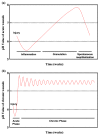Role of pH Value in Clinically Relevant Diagnosis
- PMID: 32079129
- PMCID: PMC7167948
- DOI: 10.3390/diagnostics10020107
Role of pH Value in Clinically Relevant Diagnosis
Abstract
As a highly influential physiological factor, pH may be leveraged as a tool to diagnose physiological state. It may be especially suitable for diagnosing and assessing skin structure and wound status. Multiple innovative and elegant smart wound dressings combined with either pH sensors or drug control-released carriers have been extensively studied. Increasing our understanding of the role of pH value in clinically relevant diagnostics should assist clinicians and improve personal health management in the home. In this review, we summarized a number of articles and discussed the role of pH on the skin surface as well as the factors that influence skin pH and pH-relevant skin diseases, but also the relationship of skin pH to the wound healing process, including its influence on the activity of proteases, bacterial enterotoxin, and some antibacterial agents. A great number of papers discussing physiological pH value have been published in recent decades, far too many to be included in this review. Here, we have focused on the impact of pH on wounds and skin with an emphasis on clinically relevant diagnosis toward effective treatment. We have also summarized the differences in skin structure and wound care between adults and infants, noting that infants have fragile skin and poor skin barriers, which makes them more vulnerable to skin damage and compels particular care, especially for wounds.
Keywords: diagnosis; pH value; skin; wound.
Conflict of interest statement
The funders had no role in the design of the study; in the collection, analyses, or interpretation of data; in the writing of the manuscript, or in the decision to publish the results.
Figures





References
Publication types
Grants and funding
LinkOut - more resources
Full Text Sources
Other Literature Sources
Research Materials

